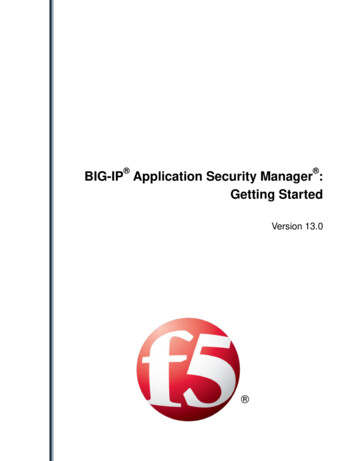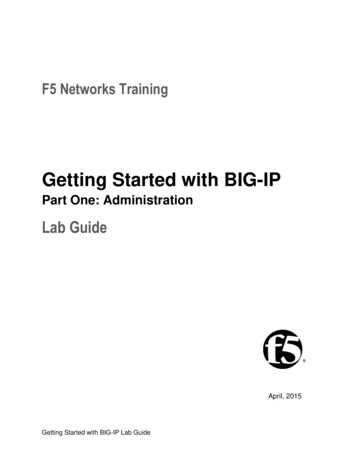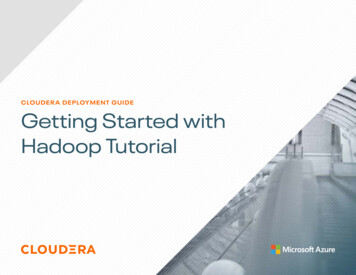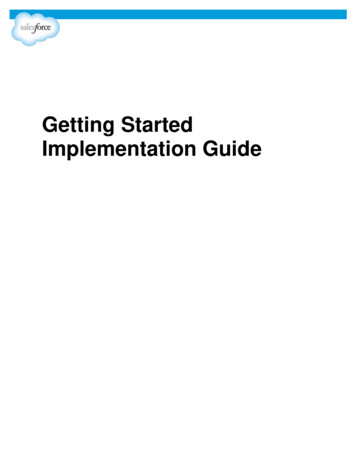
Transcription
GETTING STARTED GUIDEGETTING STARTED WITH SPLUNK FORAPPLICATION MANAGEMENTA step-by-step guide to improving application insight
GETTING STARTED GUIDEIntroductionWhen you’re identifying data sources:Applications are the lifeblood of your organization. Think about your developer, operations andThey support the processes that engage yourcustomers, partners and employees. And all ofthese applications need to deliver an exceptionalexperience—because an app that’s down can costyour organization thousands of dollars per minute.This guide outlines some of the insights you can gainby using Splunk software to monitor your applicationstack and troubleshoot problems that affect uptimebusiness teams- Developers want to understand how apps arebeing used and where there are performanceproblems, so they can quickly isolate bugs anddeliver new and improved apps.- Operations teams are often the “first line ofdefense” for app issues, as they need to quicklytriage and isolate problems. These stakeholdersand performance.want to proactively monitor applications andBenefits of better application managementpotential issues.Building great apps take more than intuitive design.They need to be reliable, available, responsive,error-free and capable of scaling. It’s also importantto know what aspects of your application are usedfrequently. That way, business and developmentteams can prioritize new features and enhanceinfrastructure to find leading indicators of- Business stakeholders want to understandwhether applications are delivering againstservice-level agreements and keyperformance indicators. Accelerate onboarding and analyzing your dataapplication design, and DevOps teams can providewith Splunk Appssufficient capacity relative to demand.- There are hundreds of apps on Splunkbasethat you can install to your Splunk instance.When an application fails, it’s often becauseSearch for the key infrastructure types you have,of changes that took place in the application oras well as other IT operations and APM tools.underlying infrastructure. Two of the mostcommon examples: A bug is introduced into an application Configuration changes are made to underlyinginfrastructureYour best defense is to inventory all the componentsof both the application and the infrastructurethat supports it. That way, you can quickly triageproblems, monitor the entire stack and understandthe impact of usage—not only with applicationexecution, but of the infrastructure as well.Getting started- Installing apps is quick and easy. The interfaceguides you through the steps, and manyapps have wizards that help you collect andindex data. Support all application platforms—more appsare being delivered through web browsers andon mobile platforms. Gaining insight into theend user experience is important, and you shouldensure you’re collecting the right data sources.For example, mobile SDKs are an effective wayto mine machine data from mobile apps. Get insights into supporting infrastructure—some application components are accessibleIf you’re already using Splunk software to monitorto you; others—such as data from a PaaS- oryour key infrastructure components, you’re ahead ofSaaS-based application component—aren’t. Youthe game. Many of the data sources you’re collectingmay not gain insight from within the component,and analyzing are the same ones you need forbut you can use wire data to gain insight onapplication monitoring and troubleshooting.transaction length, type and payload.Getting Started with Application Management2
GETTING STARTED GUIDEData Sources TableData TypeWhere to Find ItWhat It Can Tell YouOS, virtualizationand container logsand metricsSyslog via managementinterfaces, APIs, etc.Health, performance and availability ofunderlying infrastructureWeb andapplication serverlogs and metricsLog4j, popular webservers (such as Apache),application servers (such asWebSphere and NGINX)Usage, clickstream insights, relationships betweenapplication components, configuration changesDatabase logs andmetricsLogs for databasesUsage, database errors, configuration changes,specific queries and source of queriesNetwork and otherinfrastructure logsNetwork device managers,message queues, otherdevice logsAdditional insight on availability, performance andusage of supporting infrastructureApplication logsDefined by applicationdevelopersAnything that developers want to log that helpsthem assess app execution. Developers evolve theirlogging over time to include key value pairs, sothey can associate usage and other attributesMobile client dataMobile app SDKsInsight on app usage, performance, crashes and otheritems from the perspective of the mobile app userWire dataWire data probes(software based)Communication between app component, applicationresponse times and payload of applications (even when youmay not have direct visibility to some app components)APM dataAPM toolsEnd user response time, byte-code level insighton app execution, JVM, .NET, php, node.js serverperformance metricsAPI componentsAPI dataUsage, performance and payload of APIsGetting Started with Application Management3
GETTING STARTED GUIDEUsing Splunk for Application Management1) Get Baselines of Infrastructure Performance What to look for: Errors in log files Why? You can perform real-time analysis thatprovides immediate insight into problems.Additionally, log files often provide insight intowhy the error occurred Example search: ERROR timechart count2) Monitor for Application Usage Trends What to look for: HTTP status codes as a proxyfor number of web pages served Why? You can get insight into when, who andwhat people are doing with your application Example search: sourcetype access* timechart count3) Monitor Application Transactions What to look for: Correlate timestamps ofvarious application and infrastructurecomponents to assess response time and status Why? You can understand performance as wellas identify downtime Example search: sourcetype access* timecharg avg(time taken)4) Add User and Customer Context What to look for: Correlation between acustomer ID, transaction ID and a customername in an external data source Why? This enables you to add business contextto dashboards and alerts, which line of business(LOB) stakeholders find especially useful Example search: . sum(revenue)Getting Started with Application Management4
GETTING STARTED GUIDE4) Measure and manage to SLAs and KPIs What to look for: KPIs and SLAs that thebusiness and IT are aligned on Why? Present SLAs and KPIs to prioritize alertand communication application outcomes tobusiness stakeholdersCUSTOMER SPOTLIGHTEnerNOC is a Boston-based provider of energycloud components, administrators can performintelligence software that helps its customers—workload and user analytics in real time and overelectric power grid operators, businesses andlarge historical data sets.utilities—optimize energy use. The company’sEnergy Intelligence Software (EIS) platformSplunk Enterprise monitors core platform services,continuously monitors real-time energy data,ensuring that data is processed, with high error-including data from more than 30,000 energyfree throughput and near zero latency. In addition,sensors and smart meters. The company hadSplunk Enterprise plays a vital role in creatingbuilt an application to analyze data from systema dynamic DevOps environment. Using Splunkand web logs, but it was difficult to scale andEnterprise for real-time metrics, EnerNOC’sfrequently crashed.developers and QA team test code in stagingenvironments to gauge functionality, scalabilityThe firm now uses Splunk software to monitorand performance under peak loads. The DevOpsconsumption and output for demand-responseteam then relies on the same Splunk dashboardsevents while tracking performance of the data-to further refine applications the moment theycollection infrastructure to meet SLAs. Withare placed into production to preserve reliabilityviews into the platform’s public and privateand customer satisfaction.SummaryEffective application management isn’t just a “nice to have”—it’s critical to the success of your organization.Using this guide and data sources you may already be analyzing, you can quickly optimize your applicationuptime, performance and delivery.Try Splunk Cloud or Splunk Enterprise for free or learn more about application delivery.Already have Splunk? Download Splunk Apps on Splunkbase.Learn more: www.splunk.com/asksales 2017 Splunk Inc. All rights reserved. Splunk, Splunk , Listen to Your Data, The Engine for Machine Data, Splunk Cloud, Splunk Lightand SPL are trademarks and registered trademarks of Splunk Inc. in the United States and other countries. All other brand names,product names, or trademarks belong to their respective ment-102
GETTING STARTED GUIDE GETTING STARTED WITH SPLUNK FOR APPLICATION MANAGEM











